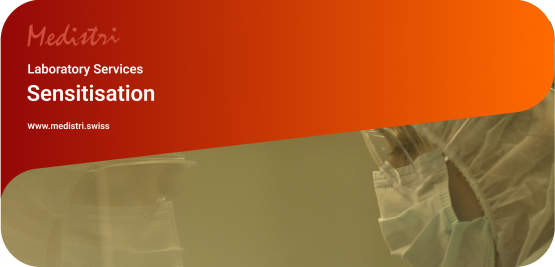(Download: Sensitisation in PDF by Medistri)
Sensitization is an inflammatory immune response that occurs only in some people after repeated exposure to a product. Sensitization has symptoms similar to irritation (e.g., a red, itchy, bumpy rash). However, sensitization symptoms are caused by the body’s immune reactivity to the product (or product components). In contrast, irritation symptoms are caused by the product. A sensitization reaction is a form of allergic reaction.
Sensitisation testing ensures the safety of medical devices by assessing their compatibility with biological systems and their potential to cause harm or adverse reactions.
👉 This is crucial as it helps prevent potential allergic reactions in patients following repeated exposure to the device.
Sensitisation testing in the biocompatibility industry is typically performed using both in vivo (animal-based) and in vitro (lab-based) methods. At Medistri, we use In Vitro Testing.
In vitro tests are conducted in a controlled lab environment. These tests are becoming more prevalent due to ethical considerations and the desire to reduce animal testing. One common in vitro method is the use of skin models to test for potential irritation. The test extract and a dye are applied to the skin model and incubated for a certain time. The percentage of living cells is then determined, which gives an indication of the irritant potential of the test substance.
It’s important to note that the specific test method chosen depends on the nature of the medical device and the route of exposure to the body.
These tests are conducted according to the guidelines provided by ISO 10993-10:2021 "Biological evaluation of medical devices Part 10: Tests for skin sensitisation".
ISO 10993-10:2021, titled “Biological Evaluation of Medical Devices Part 10: Tests for Skin Sensitisation,” is a standard that specifies the procedure for assessing medical devices and their constituent materials with regard to their potential to induce skin sensitisation.
ISO 10993-10:2021 outlines the procedure for evaluating the potential of medical devices and their constituent materials to induce skin sensitisation. The standard includes details of in vivo (animal-based) skin sensitisation test procedures. It also encourages the use of in vitro (lab-based) methods as the industry moves towards reducing animal testing.
👉 ISO 10993-10:2021 also provides key factors for the interpretation of the results and guidance on the choice of test methods.
This standard is part of the larger ISO 10993 series, which provides guidelines for the biological evaluation of medical devices. These standards are crucial in ensuring the safety and efficacy of medical devices.
🎯 To learn more about Medistri’s Sensitisation Testing, visit on our website here or directly contact our team at contact@medistri.swiss.
- The Medistri Team
#Medistri
